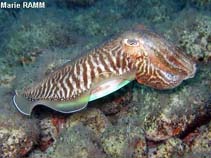Sepia officinalis Linnaeus, 1758
Common cuttlefish| Native range | All suitable habitat | Point map | Year 2050 |

|
| This map was computer-generated and has not yet been reviewed. |
| Sepia officinalis AquaMaps Data sources: GBIF OBIS |
Classification / Names Populärnamn | synonymer | CoL | ITIS | WoRMS
Cephalopoda | Sepiida | Sepiidae
Environment: milieu / climate zone / djupintervall / distribution range Ekologi
; djupintervall 0 - 242 m (Ref. 1695), usually 0 - 50 m (Ref. 88010). Tropical, preferred 21°C (Ref. 107945); 62°N - 4°N, 32°W - 37°E (Ref. 1695)
Distribution Länder | FAO områden | Ekosystem | Förekomster | Utplanteringar
Eastern Atlantic and the Mediterranean: from the Shetlands and southern Norway (stray in the Baltic Sea), south to the Mediterranean Sea to northwestern Africa.
Length at first maturity / Size / Weight / Age
Könsmognad: Lm ?, range 9 - ? cm Max length : 49.0 cm ML hane/ej könsbestämd; (Ref. 1695); publicerad maxvikt: 4.0 kg (Ref. 1695)
Life cycle and mating behavior Könsmognad | Reproduktion | Lek | Eggs | Fecundity | Larvae
Main reference
referenser | Koordinator | Medarbetare
Schneider, W. 1990 FAO species identification sheets for fishery purposes. Field guide to the commercial marine resources of the Gulf of Guinea. Prepared and published with the support of the FAO Regional Office for Africa. Rome: FAO. 268 p. (Ref. 417)
IUCN Red List Status
(Ref. 130435: Version 2025-1)
CITES status (Ref. 108899)
CMS (Ref. 116361)
Threat to humans
Human uses
Fiskeri: kommersiell
FAO - Vattenbruk: production; fiskeri: landings, species profile | FIRMS (Stock assessments) | FishSource | Sea Around Us
Verktyg
Ytterligare information
Max. ages / sizes
Length-weight rel.
Length-length rel.
Length-frequencies
Mass conversion
Abundans
Internet-källor
BHL | BOLD Systems | CISTI | DiscoverLife | FAO(fiskeri: species profile; publication : search) | Fishipedia | GenBank (genome, nucleotide) | GloBI | Gomexsi | Google Books | Google Scholar | Google | PubMed | Tree of Life | Wikipedia (Go, sök) | Zoological Record



